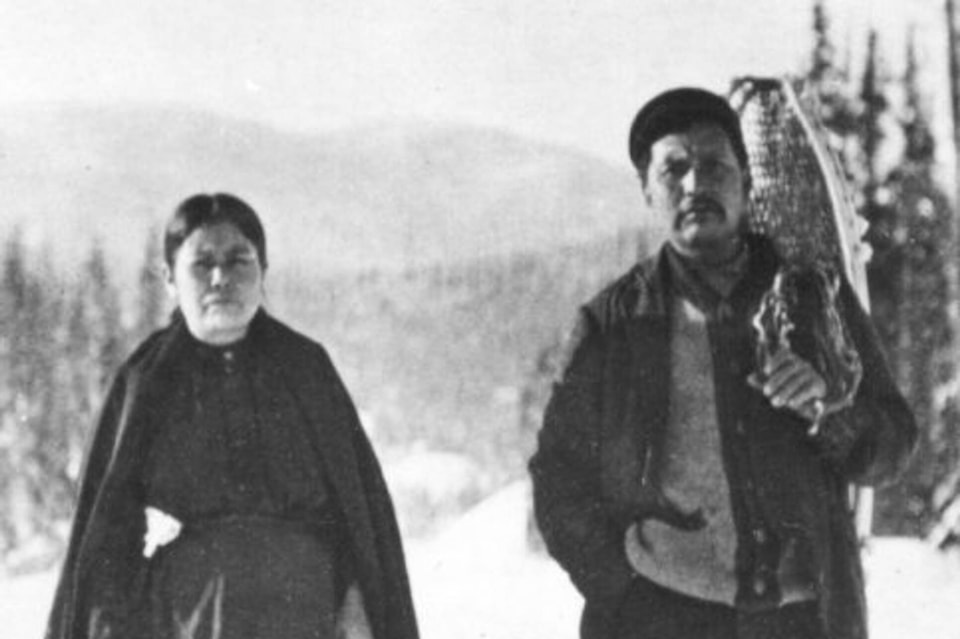The City of Terrace wants to rename the Grand Trunk Pathway, the multi-use trail connecting the downtown west to the Kalum River Bridge.
Named after the company which built the northern rail route to the Pacific ending at Prince Rupert, the path should be known as the Nelson Trail after Charles and Emma Nelson, a prominent Tsimshian couple living at Kitsumkalum in the late 19th and early 20th centuries, council has decided.
Terrace Mayor Sean Bujtas, who introduced the idea as a notice of motion at the June 26 council meeting, said a name change reflects the connection of Kitsumkalum, just west of the Kalum River, to Terrace, because of the trail.
“My intention here is not to delete settler history, as it is part of our history but I feel we need to open our eyes and hearts to the history of this land before the settlers were here,” he said.
It’s also fitting, Bujtas continued, because Charles Nelson was injured and became lame when he and his dogsled were lifted up and thrown aside by a railway snowplow during a snowstorm.
“And now we have a safe passage between the City of Terrace and Kitsumkalum,” he said.
Charles Nelson died in 1930 at the age of 62 and Emma Nelson died in 1959 at the age of 105.
The mayor said the idea of a new name grew out of conversations between himself and Kitsumkalum Chief Councillor Don Roberts.
“He expressed an interest in giving it the exact same name,” Bujtas said, adding he was happy the two were on the same page.
The new name is also the City of Terrace’s first significant physical recognition of reconciliation.
“Reconciliation is something that is ongoing forever, honestly. And I do think this is a little piece of reconciliation. Connecting the communities and making this safe passage together is a piece of it for sure. But it’s definitely not the be all and end all. There’s still lots of work to be done,” said Bujtas.
The mayor’s renaming motion was seconded by Terrace City Councillor James Cordeiro and there was no opposition.
It will now be forwarded to Kitsumkalum for its consideration or for a mutually agreed upon different name.
Councillor Dave Gordon said the construction of railways in Canada came at a cost, noting that graves in a Tsimshian graveyard just on the west side of the Kalum River near where it meets the Skeena River were dug up and moved to allow Grand Trunk rails to be laid.
Councillor Chris Apps said renaming the trail would acknowledge what he called the complex history between Indigenous people and railways.
“It’s a natural progression that lives up to not only tightening the connections between our communities, literally, with respect to the pathway, but also in a more meaningful way around how we work together and integrate more indigenous representation into our everyday lives,” he said.
Council also approved of a second suggestion from the mayor and that is to arrange with Kitsumkalum a two-community celebration when the trail is finally completed.
Construction of the final segment from Frank St. to the Kalum River Bridge, a one-mile long stretch called the Skeena River Walk within construction planning documents, began last year and continued with paving of the three-metre wide trail this May.
Unlike the first trail portions which run in between the CN line and Hwy 16, this final one runs on the north side of the highway, mainly through highways ministry right of way.
Construction of the first section of the Grand Trunk Pathway became a 2000 millennium project, explaining its commonly-used name as the millennium trail.
But one portion within the final section running along the boundary of the Kalum Motel property where it touches the highway remains unbuilt because the city and the property owner could not reach a purchase agreement.
The city is now expropriating the section of property it needs and expects to have that section completed later this year.
Although the trail will finish at the Kalum River Bridge, the bridge itself is an impediment for ongoing pedestrian, cycling or other traffic. A sign at the trail’s end tells cyclists to dismount and use a too-narrow and high sidewalk running adjacent to the highway portion of the bridge.
A painted line on the road surface itself intended to provide a guideline separating traffic from cyclists or other wheeled conveyances does not meet provincial standards.
There is also no connecting trail on the Kitsumkalum side of the bridge to the village itself.
Improving the Kalum River Bridge for non-vehicular traffic as well as the Sande Overpass connecting the north and southern portions of the city and the two Dudley bridges east of town toward Thornhill have become a priority for the city.
Bujtas has raised the issue twice with B.C. Transportation Minister Rob Fleming, the last just last week when the minister stopped briefly in Terrace on his way to Prince Rupert.
“The Sande Overpass is the number one priority because I think it’s the most frequented, but those other two bridges are very important as well,” Bujtas said.
All the bridges have narrow and high sidewalks, making it difficult if not impossible should people using wheelchairs or other mobility aids encounter one another, he said.
Improvements on the Old Skeena Bridge were made during its extensive and recent rehabilitation when bump outs or mini viewing platforms were added to the sidewalk to lessen congestion.
